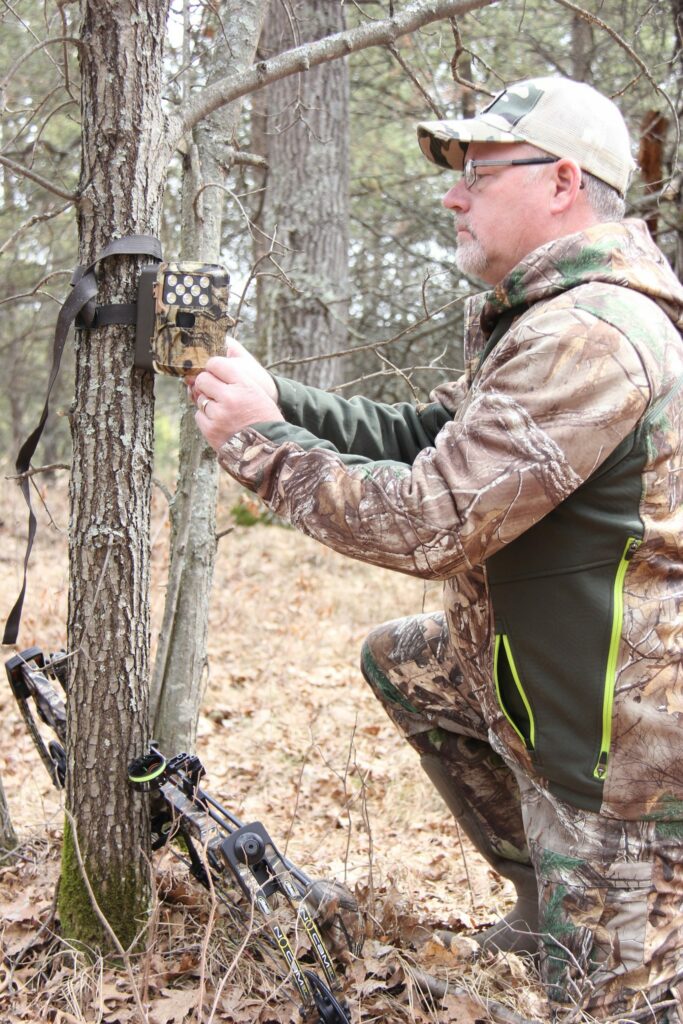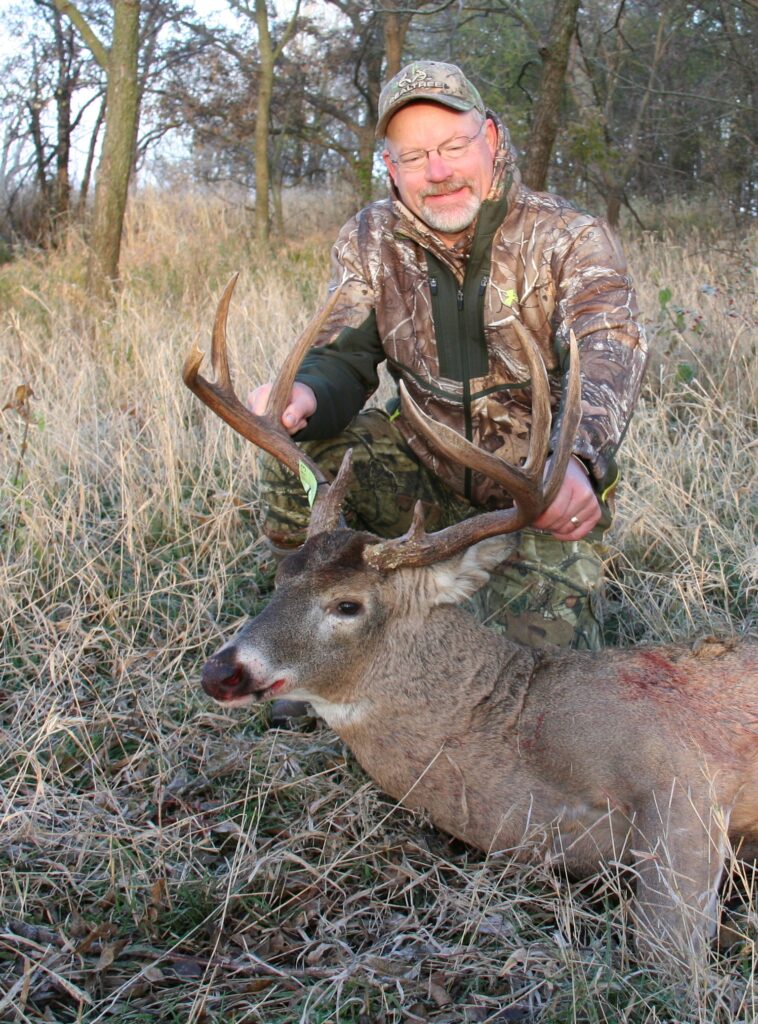By Bernie Barringer
My first bowhunting road trip was a complete bust. In my defense, it took place more than 20 years ago, so I didn’t have the advantage of Google Earth, a scouting camera or looking at the weather on my smartphone. I basically went in blind, and my results showed it. I did see some does and small bucks, and I hunted hard and used some off-beat tactics. While I don’t remember much about that first out of state hunt in the early 1990’s, I do remember that I had no idea what I was doing compared to the strategic planning and hunting methods I use today.
In fact, one of my few memories from that first trip was lying on the berm of a ditch, my bow in the grass beside me, looking at deer filtering into a green hayfield 30 yards away. I remember wondering how I could possibly get to my knees and get my bow drawn on a buck without clearing the whole field. Poor planning on my part. They say lessons learned the hard way are lessons learned well. I have learned a lot, mostly by making mistakes.
I’ve come up with seven rules—things to do and not to do—that will help any DIY hunter be more successful. Adhering to these “do’s and don’ts” have helped significantly increase my success ratio. Two decades later, I am still making mistakes and still learning, but I’m coming home with a buck in the truck often enough to feel like I have some advice to pass along. I hope these seven tips help you connect on a DIY public land buck this year.
Do your homework
Before you ever pull out of the driveway, you should have a list of likely hunting spots. Online aerial photos help immensely when it comes to choosing hunting sites. Before I set off to a new area, I usually have a pretty good idea where I am going to spend much of my time. Things that look good on Google Earth are not always what they seem, but with some experience learning how deer use cover and terrain, anyone can shorten the scouting time by picking out likely looking spots from home.
I also call local biologists, game wardens and other parties to gather as much info as I can about the area. Biologists know if food plots have been planted on the public areas and they can offer information about deer populations, age structure, etc. A game warden can offer insight into the amount of hunting pressure an area gets. I have learned to ask not only about deer hunting pressure, but also about upland bird hunters, duck hunters, small game hunters and even if the coon hunters are running their dogs through the property at night.
Do your Scouting Diligence
Once you arrive, it can be tempting to hang a stand and start hunting as soon as you find a great looking spot. But you will be much better off to spend a day learning the property before actually hunting. Spend an evening with binoculars overlooking a feeding area, walk through the area trying to determine feeding and bedding patterns. Make note of great spots with sign or with the right terrain, depending on the time of the year and stage of the rut. I cannot overstate the value of knowing the property and how deer use it well.

Use your Scouting Cameras
Scouting Cameras are one of the most important components to my scouting and learning a property. I rely on them for two main purposes. The most obvious is learning how deer are using the property. A camera will tell you which direction deer are travelling at what time. It will show you where they are feeding and bedding. You can learn about the stage of the rut by observing the behavior of the bucks.
The second and just as important knowledge I get from cameras is an evaluation of what is on the property with regards to bucks and age structure. I have been known to pass up a 125-class buck on the first day of the hunt, then realize that it was the biggest deer I saw on camera or in person during eight days of hunting there. The decision of whether or not to shoot a deer that comes within range can be made a lot easier when you know what the potential will be. No sense holding out for a 140 if there aren’t any. Cameras placed on primary scrapes will inventory most every buck in the area within three days.
Hunt Only When it’s Time
There’s nothing worse than sitting in a stand wondering if you are in the right place or not. Should you be on the other side of that ridge? Closer to the feeding or bedding area? On a different trail? Sitting over an area that’s all tore up with rubs and scrapes?
Remember what I said about putting up a stand and getting in it too soon. Having confidence in your spot makes it a lot easier to stick it out for long periods, and confidence in your spot comes from thorough scouting. I can’t overstress the importance of not settling in for a long sit until you have done the scouting and learned as much as you can from cameras.
The urge to get in a tree and get to hunting can be very strong when you arrive at a new property, but don’t do it until it’s time. Once you have a thorough knowledge of the property, you can settle into a place where you will have the optimism needed to grind it out for long hours.
Stay Mobile and Flexible
The other side of that coin is the fact that things change and you must change with them. You cannot wait for the hunt to come to you, you have to stay aggressive. You have a very short time to make things happen, so you can’t overstay a spot when you have lost the confidence in it. Food sources can change overnight with harvesting of crops. Hunting pressure can move deer around and alter patterns. A cold front with its accompanying northwest wind can make any given stand unhuntable for 2-3 days.
You have to be very aware of what’s going on around you and react quickly to changing conditions. You need to have a backup plan for a major weather change. Stay attuned to the upcoming weather, and plan accordingly. I hate the sinking feeling of sitting in a stand one evening, looking at the weather and realizing I have no place to hunt in the morning due to changing conditions. Plan at least three sits ahead, and be ready to move a set on a moment’s notice.

Work Hard and Smart
Most people aren’t used to hunting hard for 7-10 days, which is the average amount of time I will spend on a DIY road trip. Most people hunt the weekends at home or maybe a couple evenings after work. Hunting from daylight to dark, moving stands, checking cameras, constantly analyzing conditions and deer behavior is foreign to the guy who just hunts a property from home and hunts when he feels like it. About halfway through the hunt, the temptation to hit the snooze button when the alarm goes off at 5:00 a.m. can be overwhelming. That’s especially true when you start to lose confidence in your efforts.
Chances are you laid out a pile of cash for a nonresident tag and you may only get one of these trips a year. You are going to regret it for months if you don’t give it your all. Work hard all day every day. Do the things necessary to keep your confidence up and your drive at a high level. Keep thinking ahead a day or two; try not to get into the habit of reacting to the changing conditions, but learn to get ahead of them and be ready. Today’s technology in the palm of our hands can be a huge help to us, but we have to use it.
Anticipate what’s coming and be ready for it. When that alarm rings, the feeling that you will be heading out to a spot that has a legitimate chance to produce a great buck is a feeling that will get you stepping into your hunting boots in the morning with excitement for what the day might bring.

Don’t Allow your Expectations to Get to High
One of the biggest mistakes made by travelling hunters these days is having unrealistic expectations. Outdoor TV has contributed to this, I believe. You watch two nice bucks get shot during a 30-minute show. If you don’t think about the background work that went into that short segment, you can get the wrong idea. The background work most likely was put in by an outfitter who knows the deer on his property well.
The first time I go to a new property to hunt, I like to think of it as a learning experience. If I shoot a buck, great, but if not, I don’t have grandiose dreams about driving home with a 150 in the back of the truck. That dream may become a reality someday, but it will likely be after you have hunted the property a few times, you really know it well, and you have past experiences to add to the well of knowledge you draw from when making your everyday decisions.
There’s no doubt in my mind that hunting the same property many times offers a significant advantage to the hunter. But there is something to be said for the adventure of trying new areas and hunting new properties. My hunting includes a mix. I love the excitement that comes with seeing what’s over the next hill, but that’s tempered with the fact that I like to shoot a buck once in a while too, and I know my odds are better when I am hunting familiar ground.
So my advice is to take what the hunt gives you. Don’t make the mistake of letting the expectations of others dictate what you shoot or do not shoot. This is your hunt. If you are happy shooting a 120-inch 3-year-old on the eighth day, then do it. If you would rather let that deer walk and eat tag sandwich, that’s your call. The key is to go into the hunt with realistic expectations. Even the best properties do not produce a mature buck for even the best DIY hunters every year.
